Jewish reaction
Most Jews who were affected by the persecution laws initially did not fully understand the seriousness of the anti-Semitic turn taken by Fascism. They found themselves alone in facing persecution.
The first massive effort was to establish a school system alternative to the public one, so that thousands of young people would not see their schooling, and subsequently their future life, permanently compromised. Italian Jews considered the education of their children as one of the main commitments, as a defence from persecution and a reaffirmation of vitality. The most populous communities strived to set up elementary and secondary schools achieving extraordinary results.
In general, the leaders of the local Communities and of the Union of the Italian Israelite Communities sought to alleviate the painful consequences of anti-Jewish legislation by adopting a step-by-step policy, without being able to stage excessively virulent protests.
All those who were affected by the laws felt betrayed; notably, they felt that their love for their homeland, for which many of them had fought, had been betrayed. When, in June 1940, Italy went to war, many former Jewish members of the military asked the King and Mussolini if they could fight and to be therefore integrated back into the army, but their proposal was flatly rejected.
The general situation became much worse in a few months: marriages between Jews quickly declined from approximately 200 annually in 1935-1937 to 156 in 1939 and to 116 in 1940; official ‘mixed’ marriages ended completely and, after 1939, the birth rate declined dramatically. Some sought to avoid separation from the rest of society through baptism, which, however, did not change their ‘racial status’. Thousands of Italian and foreign Jews migrated to the United States, South America, and Palestine. The Zionist organizations founded Haksharoth, training centres for agricultural work in preparation for the migration to the land of Israel. Finally, dozens of people (almost 1 per thousand of those persecuted), devastated by the disastrous situation which was overwhelming them, found no other solution but suicide. They sometimes believed that it was the most extreme form of protest, as in the case of publisher Angelo Fortunato Formiggini.
Very soon, Jewish institutions had to face the impoverishment of their members, aiding the weakest. Among the organizations that rendered assistance there was, between 1938 and 1939, the Committee for Assistance to the Jews in Italy, and then the Delegation for the assistance to Jewish migrants (Delasem), led by Lelio Vittorio Valobra, which also managed ‘Villa Emma’ in Nonantola (Modena), where foreign Jewish children and youngsters without family found hospitality. Another organization that provided assistance was ‘Mensa dei Bambini’ (Children’s canteen), led by Israel Kalk.
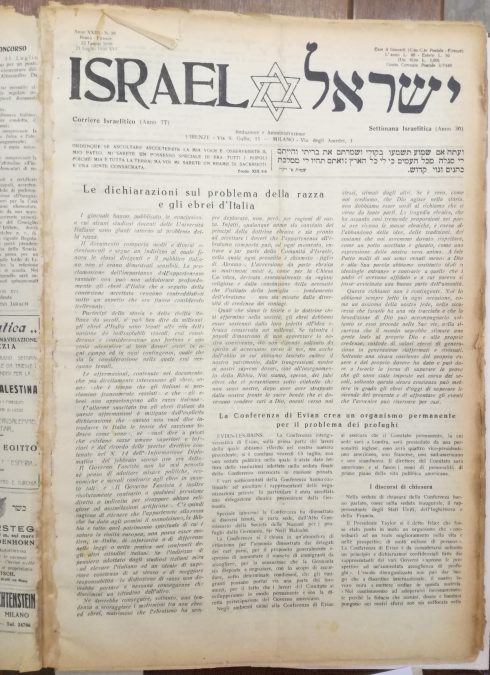
01 Israel
In the weekly Jewish-Zionist Israel anti-Jewish measures are repeatedly commented upon. On 21 July 1938, after the appearance of the ‘Manifesto of Race’, the hope is expressed that the fascist regime would not pass anti-Jewish legislation. The weekly would be closed...
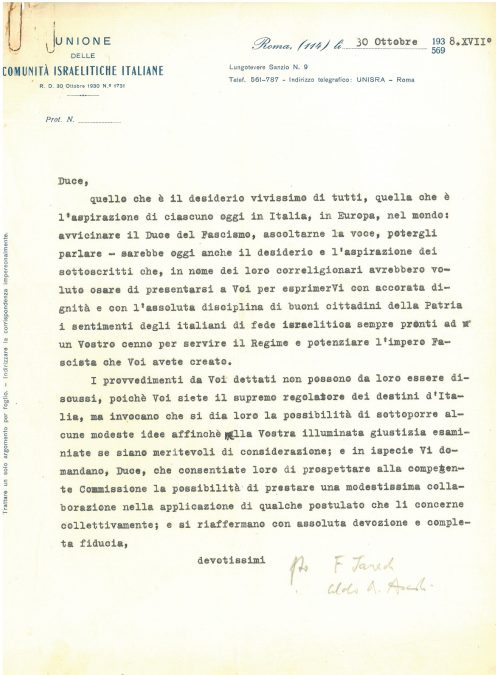
02 Unione al Duce
30 October 1938. The President of the Union of the Israelite Communities in Italy, Federico Jarach (1874-1941), and his deputy, Aldo Ascoli (1888-1970), appeal to Mussolini with the hope of reducing the impact of anti-Jewish measures. Centro bibliografico dell’Unione...
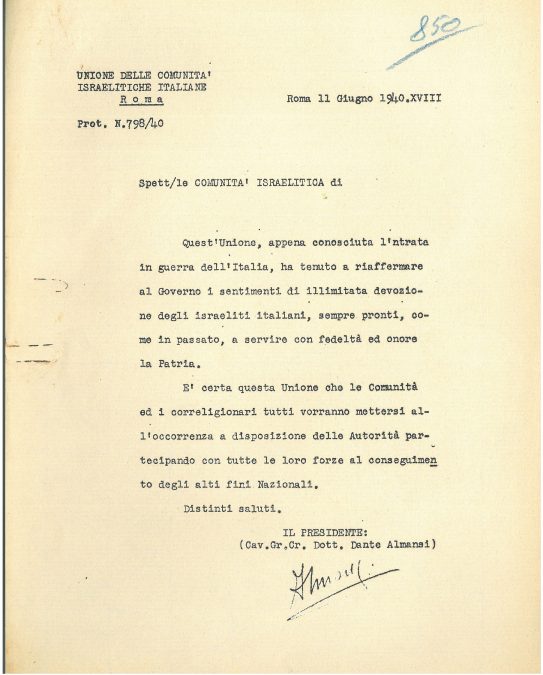
03 Unione Guerra
11 June 1940. A few days after Italy joined the war, the President of the Union of the Israelite Communities in Italy, Dante Almansi (1877-1949), calls on all the communities to reaffirm their patriotism. Centro bibliografico dell’Unione delle Comunità Ebraiche...
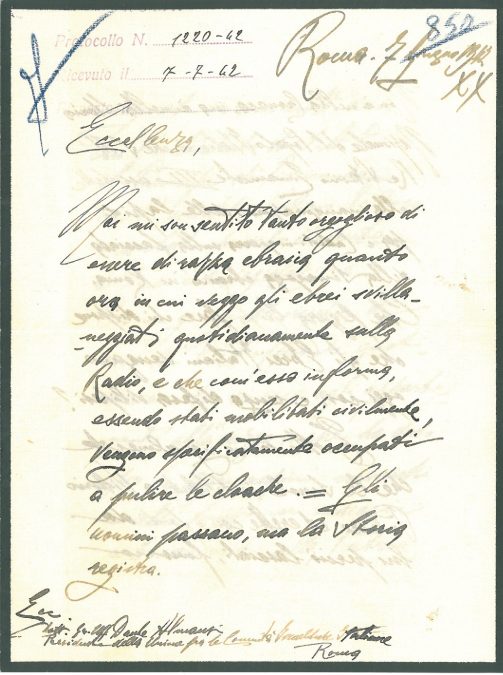
04 Benedetti
Rome, 7 June 1942. Lionello De Benedetti, after the ‘civil conscription’ order for the Jews, declares that he is proud of being a Jew in a letter to the president of the Italian Union of the Israelite Communities, Dante Almansi. Centro bibliografico dell’Unione delle...
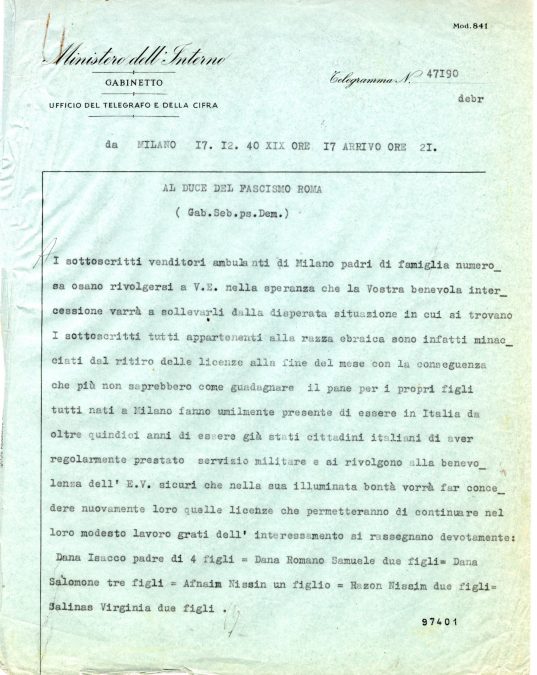
05 Venditori
Milan, 17 December 1940. In a letter to Mussolini some peddlers manifest their desperation about the planned withdrawal of licenses. Archivio Centrale dello Stato, Roma
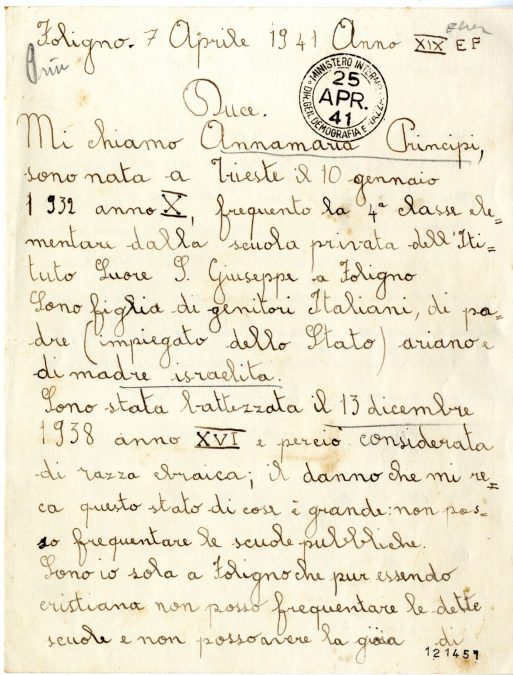
06 Principi
Foligno, 7 April 1941. Little Annamaria Principi, born in 1932 in Trieste, a ‘mixed’ Jew baptized in December 1938, asks Mussolini to be able to continue to attend the school of the Sisters of Saint Joseph. Archivio Centrale dello Stato, Roma
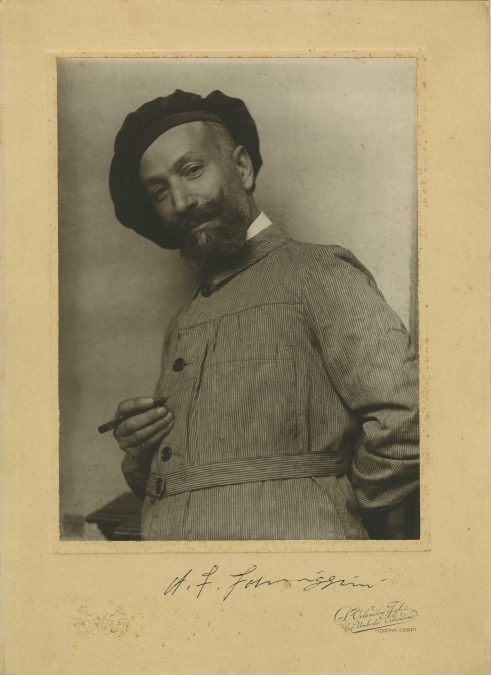
08a Formiggini
Publisher Angelo Fortunato Formiggini (1878-1938) in a photo taken between 1915 and 1920. Formiggini committed suicide in Modena on 29 November 1938 to protest against the promulgation of anti-Jewish laws. Fondazione Fotografia Modena, Fondo Giuseppe Panini
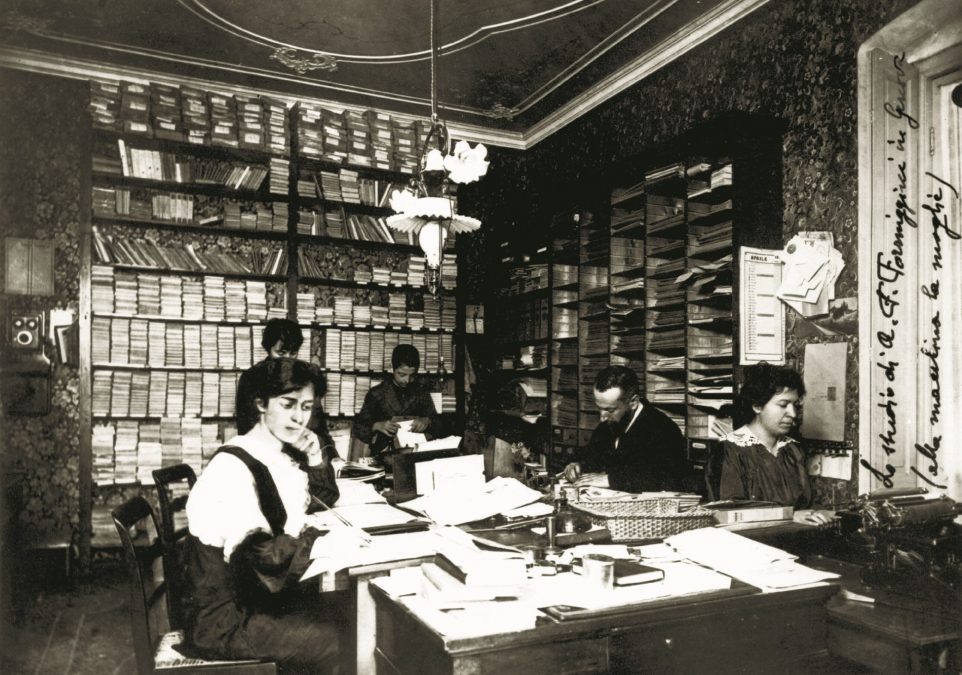
08b Formiggini
Genoa, 1912-1916. An image of the publishing house A.F. Formiggini, the seat of which was subsequently transferred to Rome. Formiggini published important works such as the ‘Chi è’ (Who’s Who) dictionary, the ‘Profili’ (Profiles) and ‘I Classici del ridere’ (Comical...
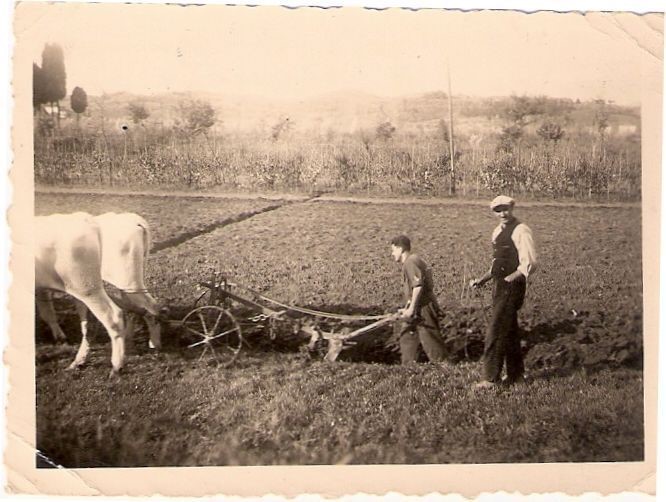
09 Godelli
Cevoli (Pisa), January 1940. Of Romanian origin but grown up in Fiume, Martino Godelli (1922-2014) had learned to plough at the Hachsharah of San Marco, a centre where young persecuted Jews were trained to emigrate to Palestine (Aliyah). Survived from Auschwitz,...
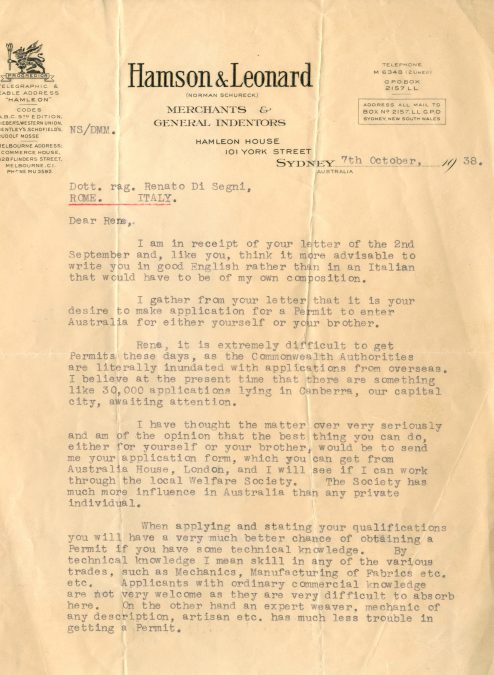
10 Emigrazione (1)(2)
Rome, 2 September 1938. Salesman Renato Di Segni (1908-1974) observes the evolution of anti-Jewish policy and tries to defend himself asking acquaintances abroad for help, in this case Norman Schureck, in Australia. Schureck answers a month later listing the...

10 Emigrazione (3)
Fiuggi, July 1942. Renato Di Segni with his wife Nora Lombroso (born in 1921) pregnant with their son Fabio. Fabio Di Segni’s Private Archive, Roma
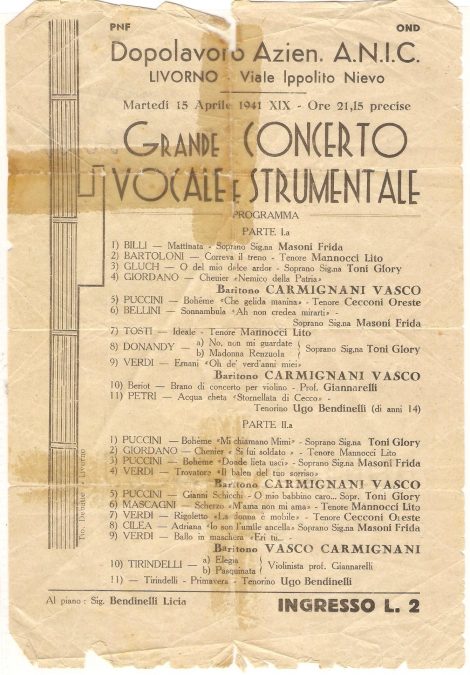
11 Frida
Livorno, 1941. The soprano from Livorno Frida Misul (1919-1992) continues to perform even after the ban for Jews from working in the show business (issued in 1940) using the pseudonym Frida Masoni. She survived Auschwitz and was one of the first women to publish her...
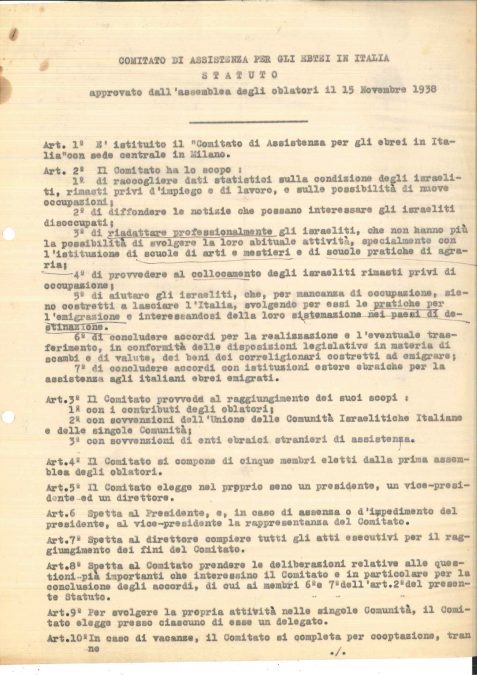
12 Comitato
Statutes of the Committee for Assistance of Jews in Italy, approved on 15 November 1938. The Committee would be dissolved in August 1939. Archivio Ebraico Terracini, Torino
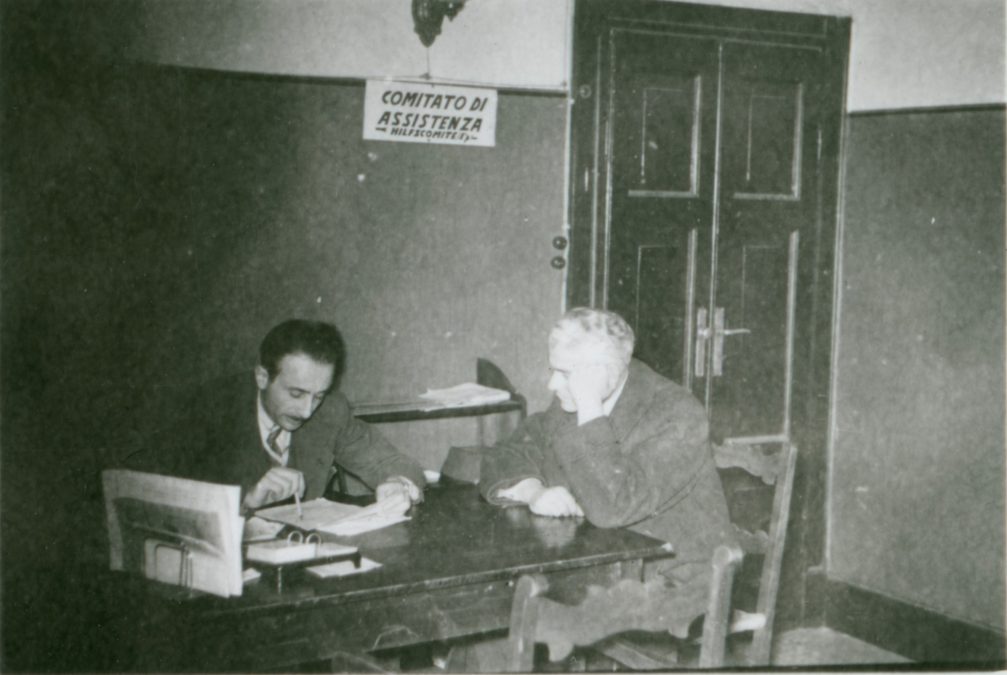
13 Comitato
Milan, 1939. A representative of the Committee for Assistance to Jews in Italy takes care of a Jew who has lost his job at the Banco di Roma. Courtesy of the American Jewish Joint Distribution Committee
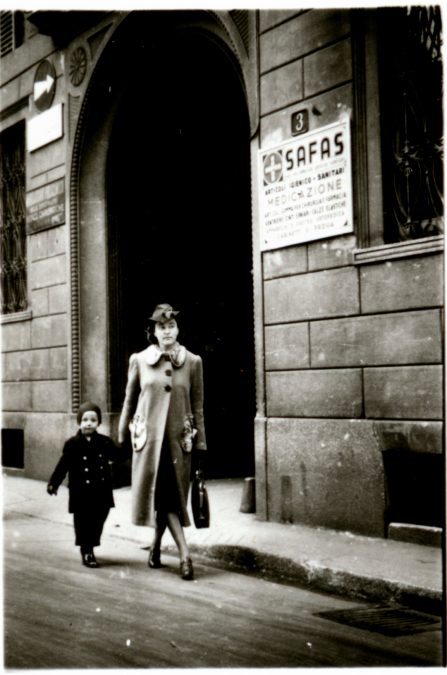
14 Comitato emigrante
Rome, 1939. A migrant Jewish woman and her child in front of the entrance of the headquarters of the Committee for Assistance to Jews in Italy. Courtesy of the American Jewish Joint Distribution Committee
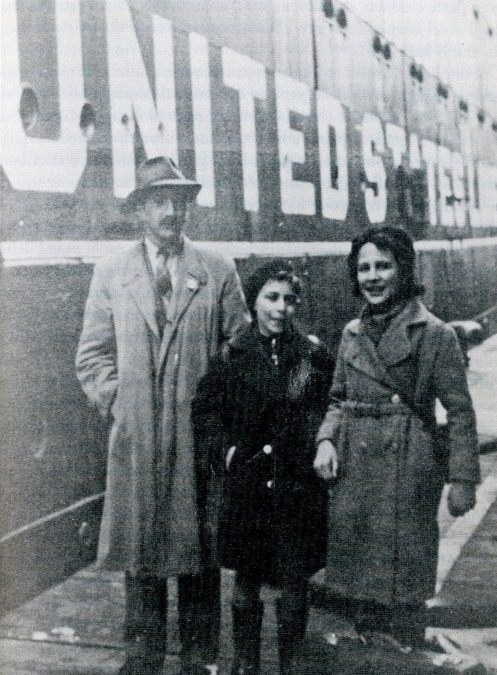
15 Emigrazione
The Port of Genoa, 1939-1940. Two Jewish children are boarding a ship leaving for the United States accompanied by a collaborator of Delasem. ‘Rinasceva una piccola speranza’. L’esilio austriaco in Italia (1938-1945), edited by Christina Köstner and Klaus Voigt, Forum...
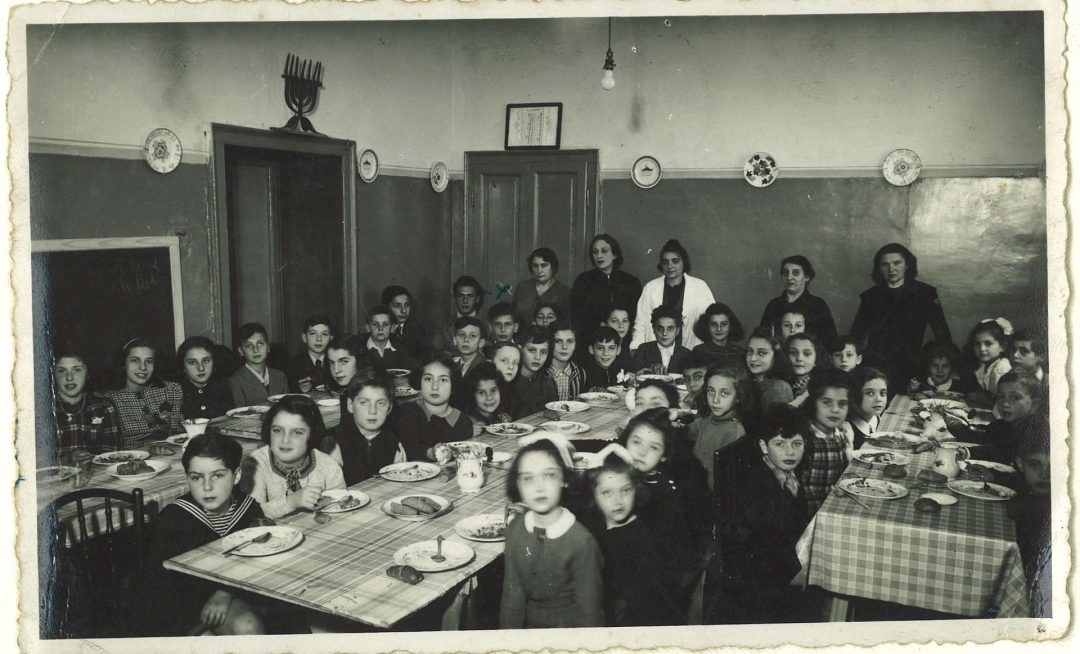
16 Mensa Kalk Fondz
Milan, Children’s Canteen, 1941. From October 1939 until September 1943 engineer Israel Kalk (1904-1980), a Jew of Latvian origin married to an Italian non-Jew, set up a canteen mainly addressed to Jewish children refugees from Germany and Austria. The organisation...
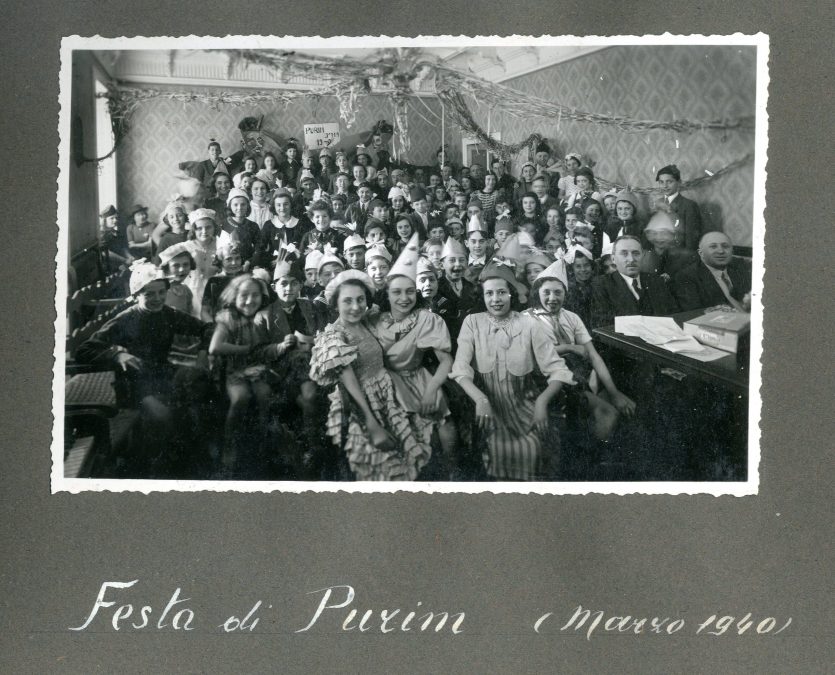
17 Mensa Kalk CDEC
Milan, Children’s Canteen. Album with photos and captions by Israel Kalk. Fondazione Centro di Documentazione Ebraica Contemporanea, Milano

18 Cartoline Mensa (1)
Postcards published by the Children’s Canteen with appeals to donate money to Jewish children in need. Fondazione Centro di Documentazione Ebraica Contemporanea, Milano
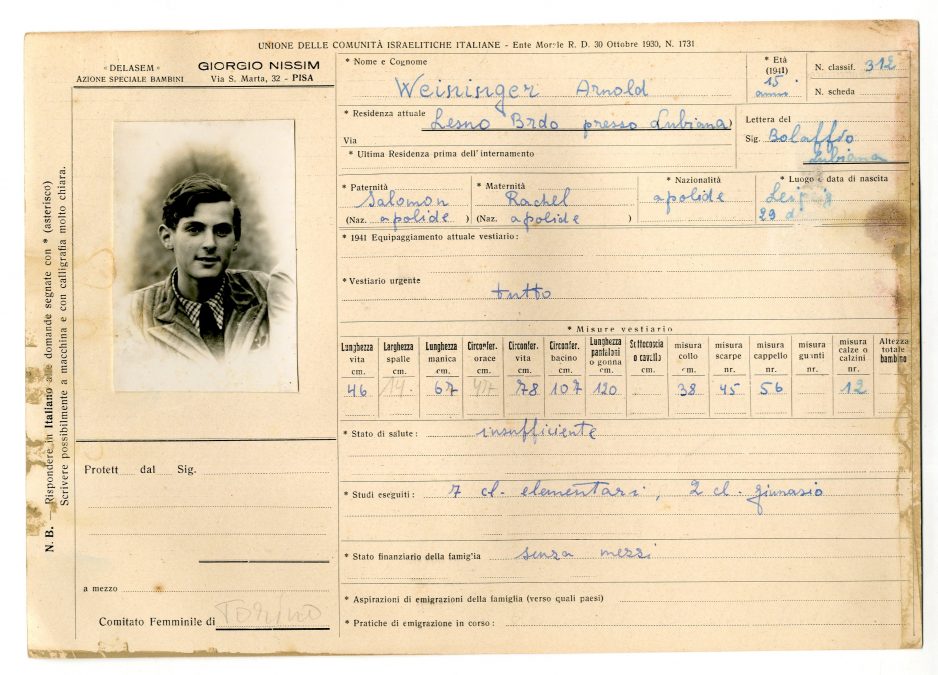
19 Delasem schede (2)
Two cards of young Jewish foreigners in need. This material was produced for the Special Children Action of Delasem. The youngest of the two is Arnold Weininger, Leipzig. After his father’s death in Sachsenhausen camp he was included in one of the last transports of...
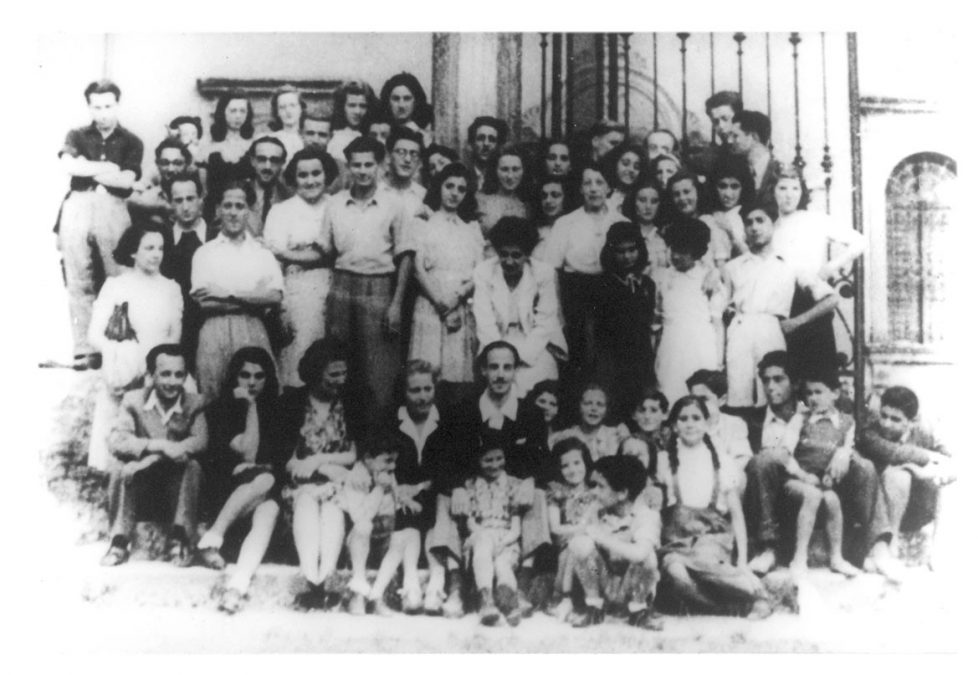
22 ragazzi
Young Germans, Austrians and Yugoslavs, with assistants and visitors, in front of a wing of Villa Emma. At the centre, Director Umberto Jacchia (born in 1916). Comune di Nonantola, Archivio storico
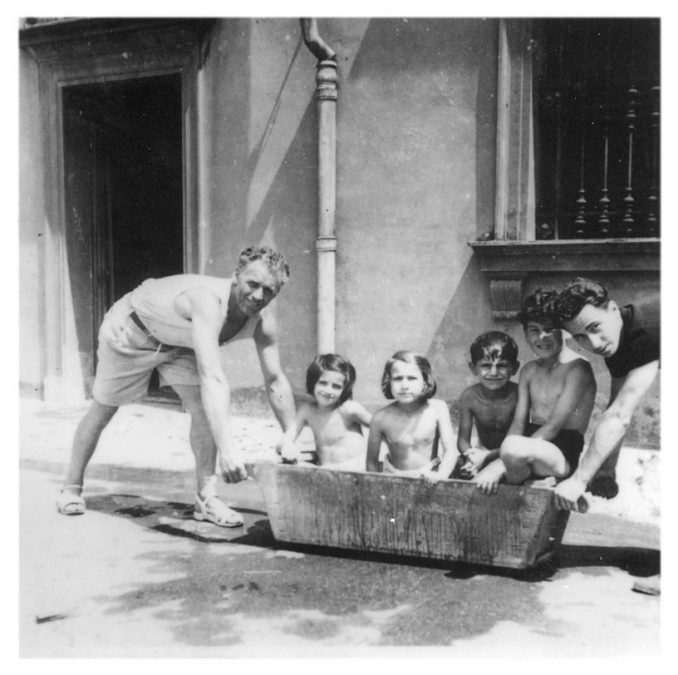
23 falegname
Carpenter Hersz Naftali Schuldenfrei, one of the instructors of Villa Emma, with four small refugees: Lea Altaras, Sida Israel, Aron Koen, and Benno Goldberg. To the right, Otto Liebling. Comune di Nonantola, Archivio storico
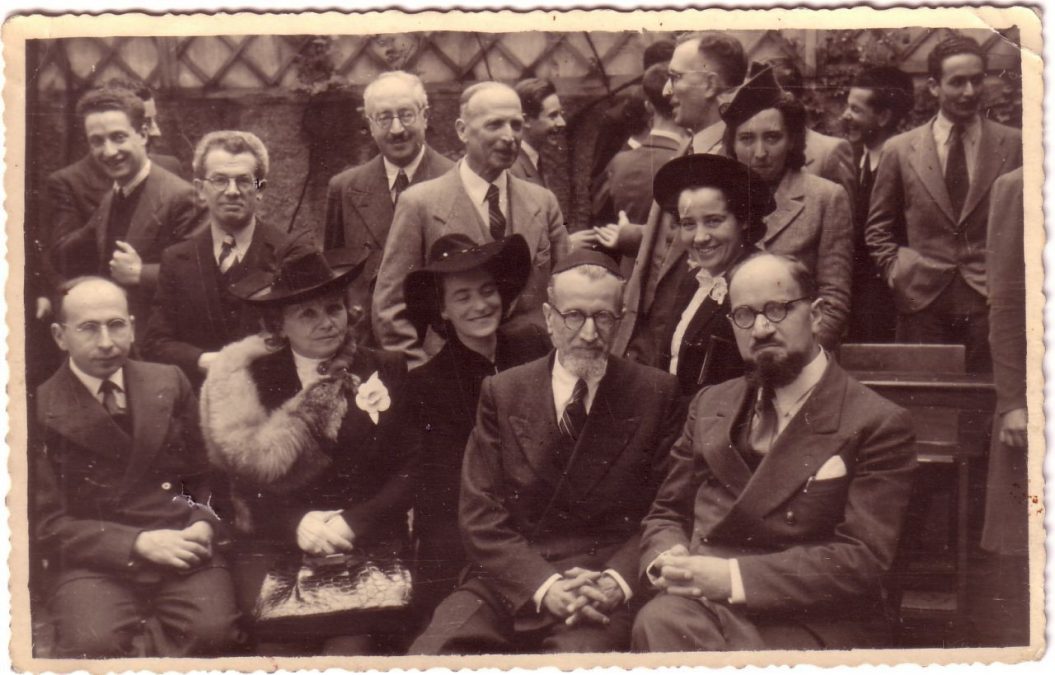
24 Milano
Milan, via Eupili, June 1942. Teachers of the Jewish school in the courtyard of the same school. In the foreground, from the left, Achille Norsa, Susanna Guggenheim, Alda Perugia, Gustavo Castelbolognesi, Joseph Colombo, and, behind, Hulda Cassuto Campagnano. In the...
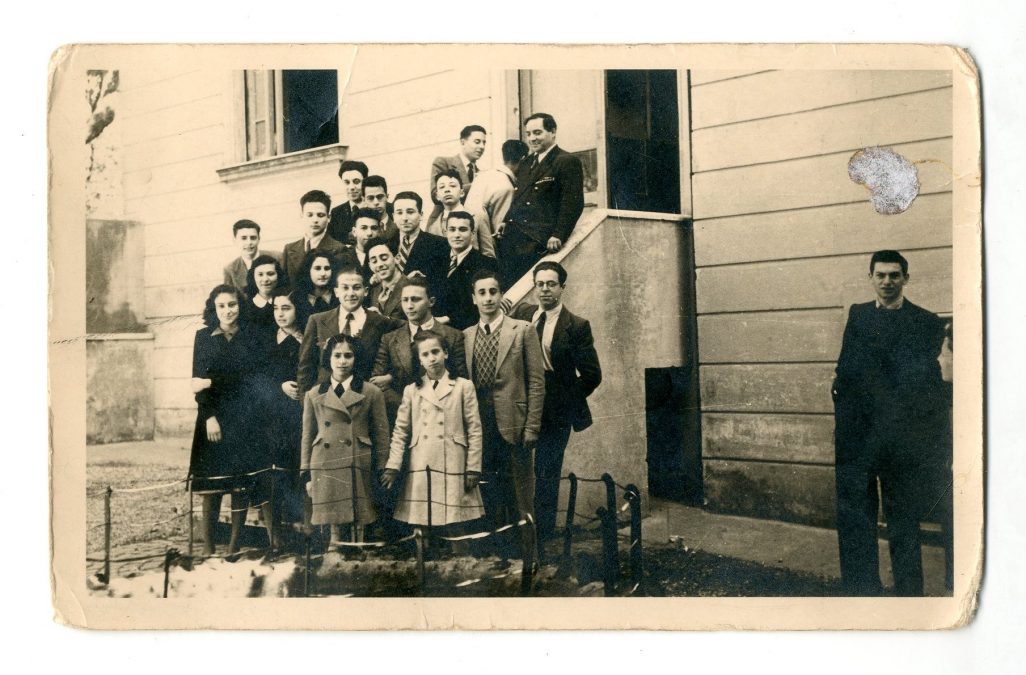
25 Roma
Rome, 1940s. Students of the Jewish High School. Among the students there are Ornella, Olga and Fabio Della Seta, Vittorio Ventura, Leopoldo Dino Cagli, Giuliana Pugliese, and Carlo Di Gioacchino. To the top, school caretaker Romeo Bondì. Silvana Ajò Cagli’s Private...
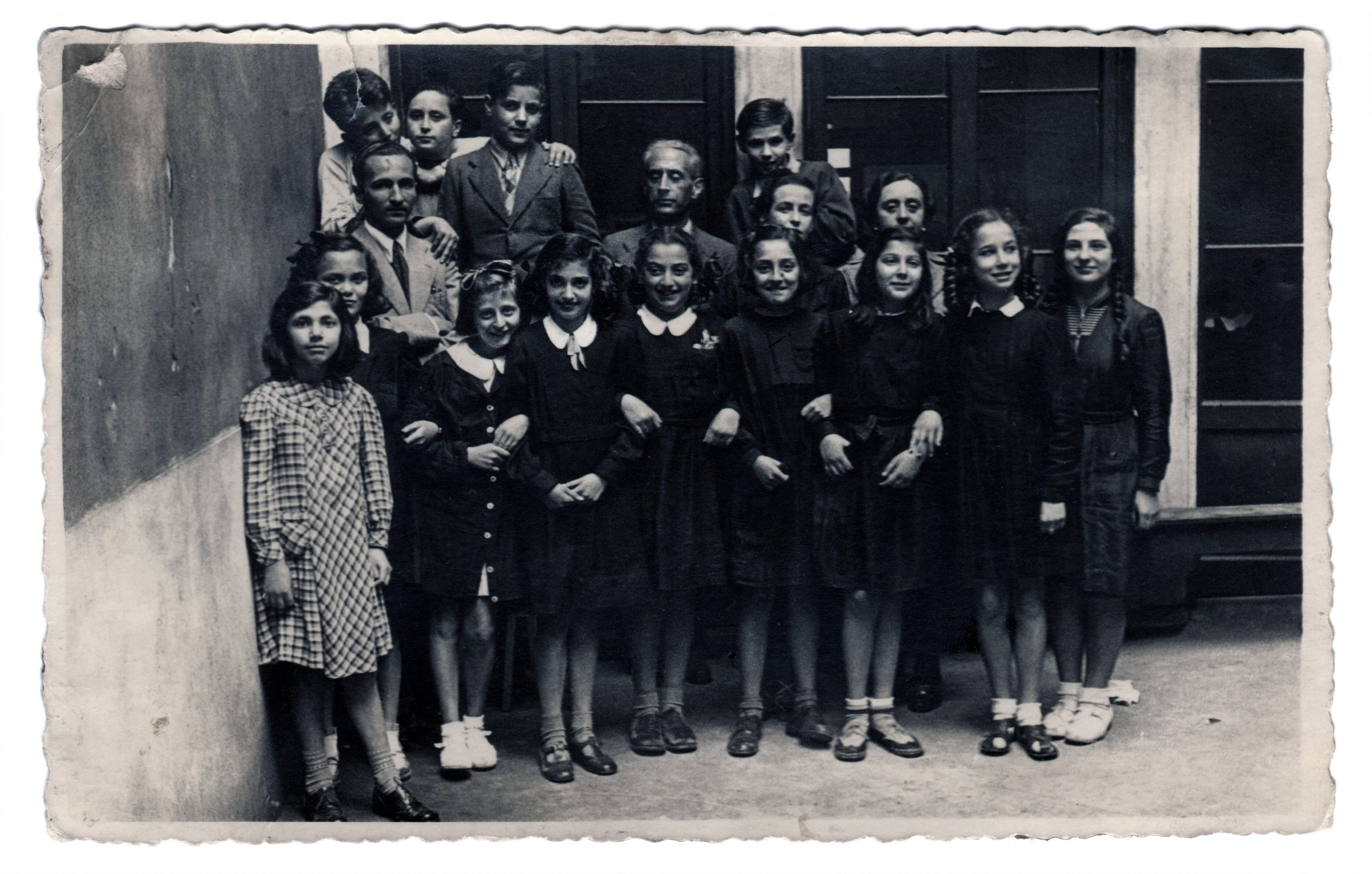
26 Venezia
Venice, school year 1939-1940. Sixth grade pupils of the Jewish school at Ponte Storto (S. Maria Formosa), with Principal Augusto Levi (1884-1944), then deported to Auschwitz, and teachers Renzo Levis, Paola Lombroso, and L. Veneziani. Students: Guido Errera, Riccardo...
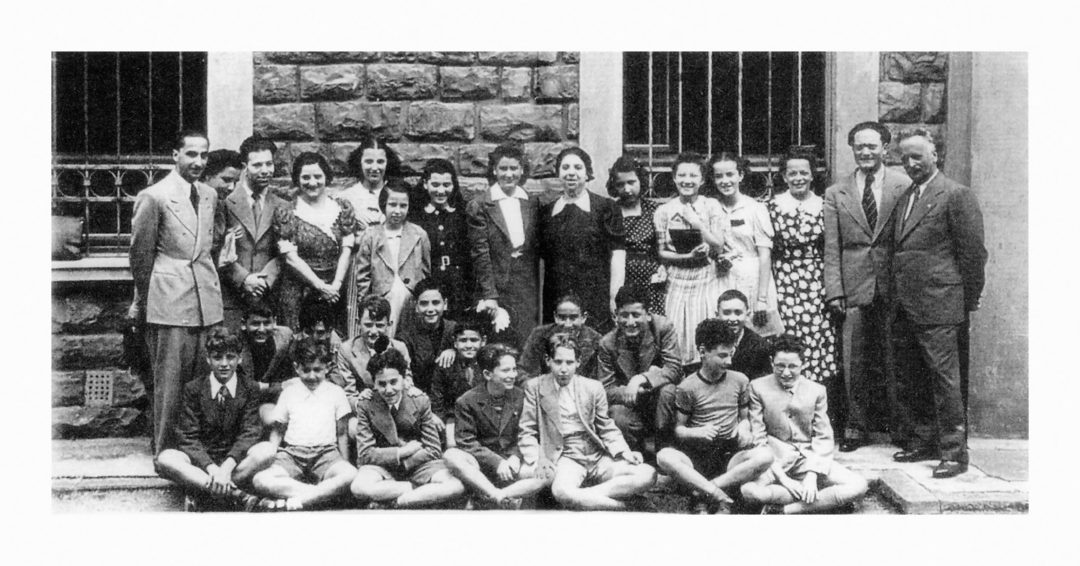
27 Trieste
Trieste, 1938-1939, Jewish secondary school. The following teachers are recognizable, standing: Dino Levi (Art history), Laura Schreiber (French), Guido Spiegel (German), Vanda Tedeschi (Literature and Philosophy), Widnar (Physical Education), Rosetta Fano, Nedda...
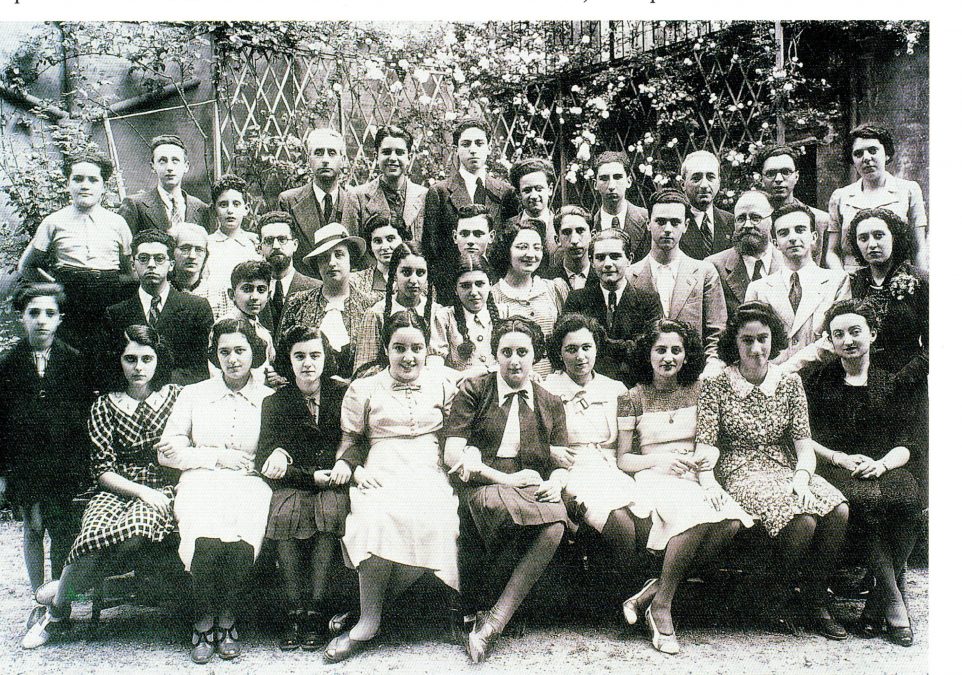
28 Padova
Padua, 1939 approximately. Jewish School established in a cottage in Via Leopardi. In the last row, the third on the left is Prof. Augusto Levi (1884-1944). Professor of physics, we owe him the organization of the Jewish schools of Padua and Venice. He will be...
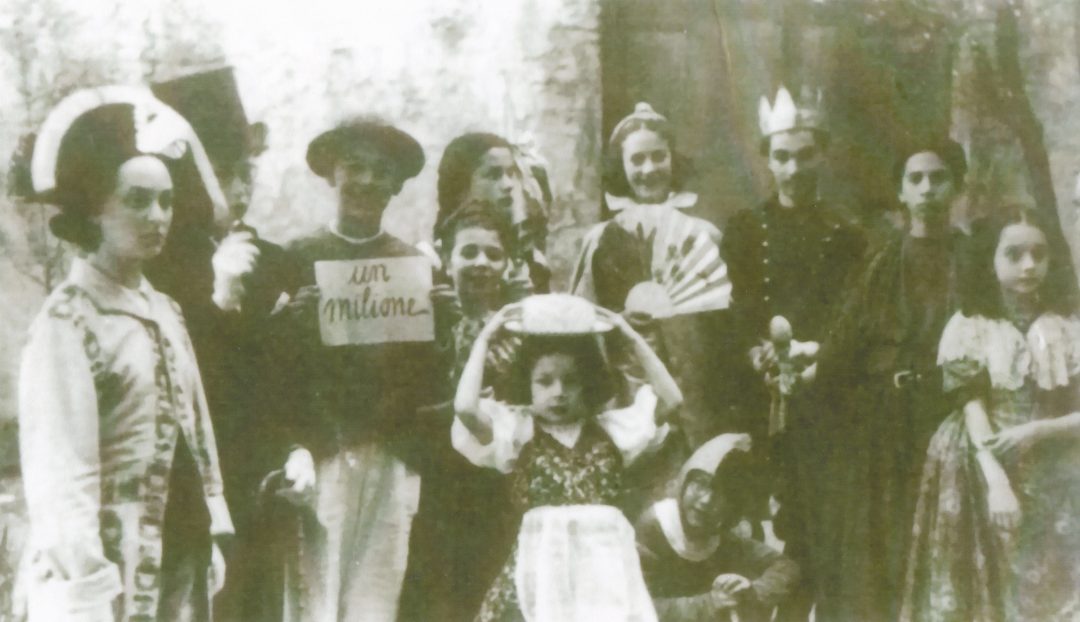
29 Ferrara
Ferrara, Passover 1942. The Jewish school of Via Vignatagliata. The young students interpret a comedy by Sergio Tofano, directed by G. Bassani. From the left: Anna Fedora Rossi, Franco Schönheit, Nello Rietti, Miriam Cividalli, Donata Ravenna, Maurizio Tedeschi,...
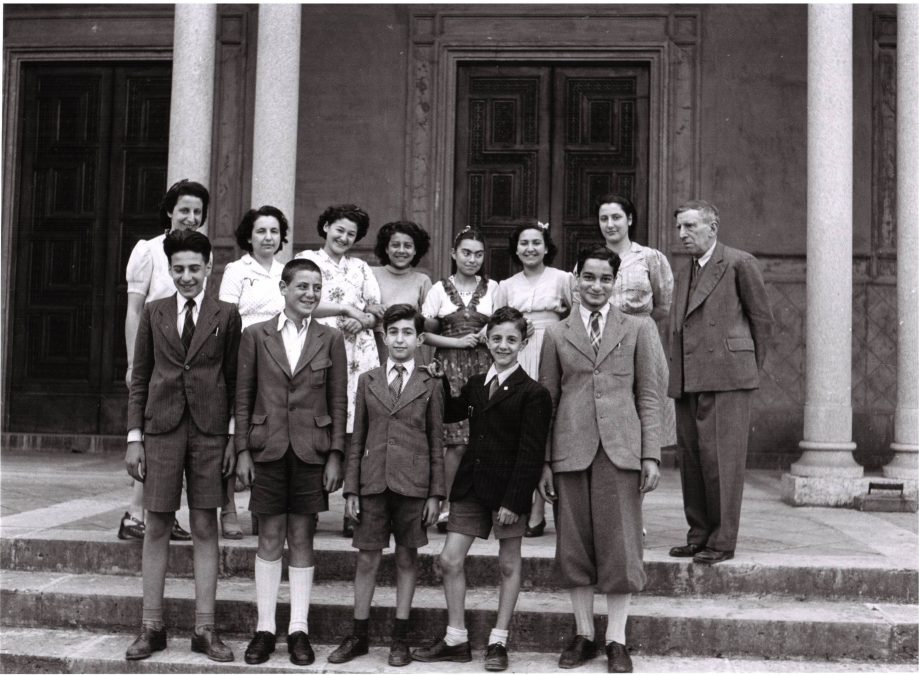
30 Firenze
Florence, April 1943. A Jewish school class. Paolo Salmon’s Private Archive, Firenze
Browse through the chapters of the exhibition
Next chapter
Previous chapter
